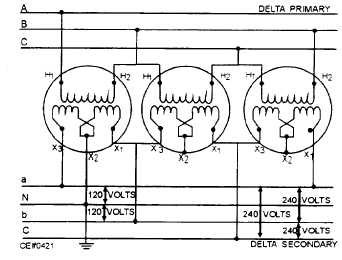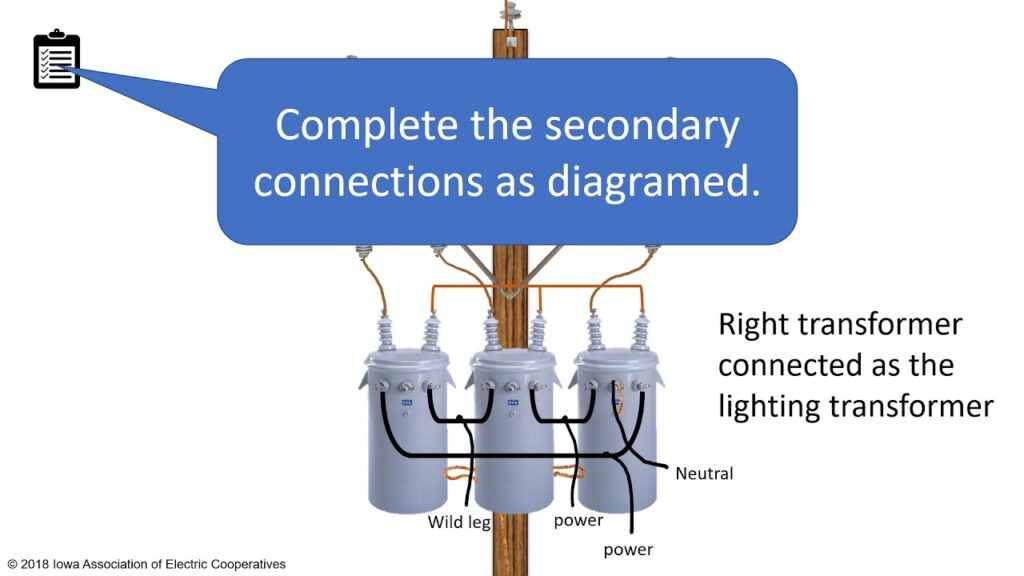A 240/480 transformer bank is used to step up or step down voltage levels in electrical systems. It ensures safe and efficient power distribution.
Transformers are essential components in electrical systems, enabling voltage conversion to match the requirements of different devices and applications. A 240/480 transformer bank plays a crucial role in both residential and industrial settings by stepping up or stepping down voltage levels.
This capability ensures that electrical equipment operates safely and efficiently without the risk of overload or damage. These transformers are designed to handle varying loads and provide stable voltage outputs, making them indispensable in maintaining the reliability and performance of electrical networks. Proper installation and maintenance are vital to ensure their long-term functionality and safety.
Basics Of 240/480 Transformers
The 240/480 transformer is a key electrical device. It changes voltage levels to make power systems safe and efficient. This guide helps you understand how it works.
Voltage Specifications
A 240/480 transformer has two voltage levels: 240 volts and 480 volts. It can step up or step down the voltage. This means it can change 240 volts to 480 volts or vice versa.
Here is a simple table to illustrate:
| Voltage Level | Function |
|---|---|
| 240 Volts | Lower Voltage |
| 480 Volts | Higher Voltage |
Primary And Secondary Windings
The transformer has two windings: primary and secondary.
- Primary winding: Receives the input voltage.
- Secondary winding: Delivers the output voltage.
These windings work together. They create a magnetic field that transforms the voltage.

Credit: www.youtube.com
Applications Of 240/480 Transformer Banks
The 240/480 transformer banks are vital in many sectors. They help convert electrical energy efficiently. Their use ensures smooth operations in various industries. Below, we’ll explore their industrial uses and commercial applications.
Industrial Uses
Industrial operations often need high power. The 240/480 transformer banks are perfect for this. They ensure machines run smoothly. Here are some key uses:
- Manufacturing Plants: They power heavy machinery.
- Mining Operations: They provide stable energy for mining equipment.
- Oil and Gas Refineries: They ensure continuous operation of refining units.
- Steel Production: They supply the energy needed for steel mills.
Using these transformers reduces downtime. It also ensures equipment longevity. This leads to cost savings and increased productivity.
Commercial Applications
In commercial settings, 240/480 transformer banks are equally important. They provide power to various facilities. Here are some common applications:
- Shopping Malls: They ensure consistent power for lighting and HVAC systems.
- Office Buildings: They support elevators and essential electrical systems.
- Hospitals: They provide reliable power for medical equipment.
- Data Centers: They ensure uninterrupted power supply for servers.
These applications highlight the critical role of transformer banks. They ensure business continuity and operational efficiency.
Design Considerations
Designing a 240/480 transformer bank involves careful planning. This ensures optimal performance and safety. Key factors include load calculations and cooling systems. These aspects are crucial for a reliable setup.
Load Calculations
Accurate load calculations are critical for transformer design. They help to determine the transformer size. Incorrect calculations can lead to overloading. This may cause transformer failure. Proper load calculations ensure efficiency and longevity.
- Identify total load demand
- Consider peak load conditions
- Account for future expansion
Use a load calculation table for better clarity:
| Load Type | Power (kW) | Voltage (V) | Current (A) |
|---|---|---|---|
| Lighting | 10 | 240 | 41.67 |
| HVAC | 20 | 240 | 83.33 |
| Machinery | 50 | 240 | 208.33 |
Cooling Systems
Cooling systems prevent overheating. They are essential for transformer safety. There are various cooling methods available.
- Natural air cooling
- Forced air cooling
- Oil cooling
Each method has its own advantages. Natural air cooling is cost-effective. Forced air cooling increases efficiency. Oil cooling provides superior heat dissipation.
Here is a comparison of cooling methods:
| Cooling Method | Advantages | Disadvantages |
|---|---|---|
| Natural Air Cooling | Low cost, Simple design | Limited efficiency |
| Forced Air Cooling | Better efficiency | Higher cost |
| Oil Cooling | Excellent heat dissipation | Requires maintenance |
Choose the appropriate cooling system based on your load requirements. This ensures optimal transformer performance.
Credit: powerlineman.com
Installation Best Practices
Proper installation of a 240/480 Transformer Bank ensures efficient operation and safety. Follow these best practices to ensure a successful installation process.
Site Selection
Choose a site that is dry and well-ventilated. Ensure the area is free from flammable materials.
Accessibility is crucial. Make sure there is enough space for maintenance and inspections.
Check for a stable, level surface to place the transformer. This prevents any tilting or movement.
Safety Protocols
- Personal Protective Equipment (PPE) is a must. Use gloves, safety glasses, and hard hats.
- Ensure the power is off before starting installation. This prevents electrical hazards.
- Follow all local codes and regulations. Compliance ensures safety and legality.
Have a first aid kit and fire extinguisher nearby. Be prepared for emergencies.
Use proper lifting techniques or equipment. Avoid injuries during heavy lifting.
| Step | Action |
|---|---|
| 1 | Verify power is off |
| 2 | Wear PPE |
| 3 | Check site conditions |
| 4 | Follow local codes |
Remember, safety and planning are the keys to a successful installation.
Maintenance Tips
Maintaining your 240/480 Transformer Bank is crucial. Proper care ensures its longevity and efficiency. Follow these tips for optimal performance.
Regular Inspections
Regular inspections are vital. They help in identifying potential issues early. Check the transformer for visible wear and tear.
- Inspect for oil leaks.
- Check electrical connections.
- Look for corrosion.
Troubleshooting Common Issues
Troubleshooting common issues can save time and money. Here are some frequent problems and solutions.
| Issue | Possible Cause | Solution |
|---|---|---|
| Overheating | Blocked vents | Clean the vents. |
| Noise | Loose parts | Tighten connections. |
| Voltage Fluctuations | Unstable power source | Check the power supply. |
For more complex issues, consult a professional. Regular maintenance keeps your transformer bank in top shape.
Energy Efficiency Strategies
Improving energy efficiency in a 240/480 Transformer Bank is crucial. It saves energy and reduces costs. Implementing effective strategies can make a big difference. Let’s explore two key methods: reducing losses and optimizing performance.
Reducing Losses
Losses in transformers can waste energy. Minimizing these losses is vital for efficiency.
- Use Low-Loss Materials: Use materials that reduce energy loss. This includes high-grade silicon steel.
- Proper Maintenance: Regular maintenance can prevent energy loss. Check for issues and fix them promptly.
- Cooling Systems: Use efficient cooling systems. These help in maintaining optimal temperatures.
Optimizing Performance
Optimizing transformer performance is essential. This ensures the system runs efficiently.
- Load Management: Distribute loads evenly. Avoid overloading the transformer.
- Regular Testing: Conduct regular tests. This helps identify and fix performance issues.
- Upgrade Technology: Use modern technology. Upgrades can improve transformer efficiency.
| Strategy | Description |
|---|---|
| Low-Loss Materials | Use high-grade silicon steel to reduce losses. |
| Proper Maintenance | Regular checks and fixes to prevent energy loss. |
| Cooling Systems | Efficient cooling to maintain optimal temperatures. |
| Load Management | Evenly distribute loads to avoid overloading. |
| Regular Testing | Identify and fix performance issues through tests. |
| Upgrade Technology | Use modern tech to enhance efficiency. |
Future Trends
The future of the 240/480 Transformer Bank is brimming with potential. This section explores the latest trends shaping the industry. From technological advancements to sustainability initiatives, the landscape is evolving rapidly. Let’s delve into these exciting developments.
Technological Advancements
New technologies are revolutionizing the 240/480 Transformer Bank. Innovations in smart grid technology are making transformers more efficient. These advancements include:
- Real-time monitoring systems
- Predictive maintenance algorithms
- Advanced data analytics
These tools help in reducing downtime and increasing reliability. They also enhance the lifespan of transformers.
Sustainability Initiatives
Sustainability is a key focus in the transformer industry. Companies are adopting eco-friendly materials and energy-efficient designs. Here are some initiatives:
- Use of biodegradable insulating fluids
- Implementation of energy-saving technologies
- Recycling and reuse of transformer components
These steps aim to reduce the carbon footprint and promote a greener planet.
Incorporating these trends ensures a sustainable and efficient future for the 240/480 Transformer Bank.

Credit: constructionmanuals.tpub.com
Frequently Asked Questions
Is 240v A Wye Or Delta?
240V can be both Wye and Delta configurations. Wye has a neutral point, Delta does not.
How To Convert 480v To 240v?
To convert 480V to 240V, use a step-down transformer. Ensure the transformer’s power rating matches your needs. Always follow safety guidelines.
What Is The Purpose Of Transformer Bank?
A transformer bank converts electrical energy to different voltage levels. It ensures efficient power distribution and reduces energy loss.
What Is The Turns Ratio On A Three Phase Four Wire 480 240 120 Volt Transformer?
The turns ratio for a three-phase four-wire 480/240/120 volt transformer is 4:2:1. This means 4 turns for 480 volts, 2 turns for 240 volts, and 1 turn for 120 volts.
Conclusion
Understanding the 240/480 transformer bank is essential for efficient power distribution. It ensures safety and reliability in various applications. By grasping its functionality, you can make informed decisions. Stay updated with industry standards to maintain optimal performance. Thank you for reading, and we hope this guide has been helpful.


